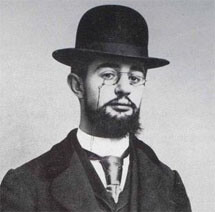Park West Toulouse-Lautrec Lithograph on Display at London Museum
It’s hard to think of an artist more closely associated with the Parisian nightlife than Henri de Toulouse-Lautrec. His iconic posters for the Moulin Rouge nightclub in Paris’ [...]

1864–1901
Henri de Toulouse-Lautrec was born at the chateau de Malromé near Albi, Tarn in France of an aristocratic bloodline – descendants of the Counts of Toulouse and Lautrec and the Viscounts of Montfa. Henri suffered from a number of health issues, mainly due to his family’s inbreeding (his parents were first cousins). He was also seriously injured as a youth – his fractured left and right thighs were stunted permanently – and his mother sent him to the thermal baths at Amélie-les-Bains in hopes of remedying his health issues. His artistic talent, however, thrived. At a very early age, Henri proved he had a talent for drawing horses, taking informal lessons with his father’s friends. In 1882, he began to study art seriously in Paris, and by 1885, had a studio in Montmartre. He exhibited at the Salon des Independants in 1889 and with Les XX in Brussels, and in 1891, his first posters brought him immediate recognition.
His color lithographs were his true masterpieces. His first lithograph celebrated the opening of Moulin Rouge and Toulouse-Lautrec was extremely prolific in the ten years he spent as a printmaker. He made his first color prints in 1892 and held a one-man show in Paris in 1893. The following year he went to Brussels, and in 1895, made his first of several visits to London where he met Oscar Wilde and Beardsley. He held a second exhibition in 1896 and visited Holland, Portugal, and Spain, but in 1898, his health began to suffer from excessive drinking. In 1899, he spent three months in a clinic recovering from an attack of Delirium Tremens (tremors resulting from alcohol withdrawal) and during his convalescence he worked on a series of drawings of the circus. After his recovery, he resumed his old life until he broke down completely and was taken to his mother’s country house where he passed away in 1901 at the young age of 37.
His first teacher had encouraged him to paint animals – particularly horses. After he began studying in Paris he met Emile Bernard and Vincent van Gogh. He was deeply influenced by the technique and subject matter of Degas and by Japanese prints, as were artists considered Impressionists and Post-Impressionists. His subject matter was centered narrowly around the life he led. He painted some portraits (many painted out-of-doors), scenes from dance halls and cafes in Montmartre (such as the Moulin Rouge or characters from Aristide Bruant’s cabaret Le Mirliton), figures of actresses, female clowns, circus artists seen backstage, and a great number of nudes in brothels and dressing rooms. He loathed posed models and strived to find moving subjects for his images.
He achieved an expansive technical range in his lifetime. He was a superb draftsman with a gift for conveying rapid movement and the entire atmosphere of a scene with a few strokes. Most of his paintings are in spirit-thinned oil paint on unprimed cardboard, using the neutral tone of the board as an element in the design. He executed a large number of posters in lithography, with superb handling of highly simplified line, large areas of flat color, and unique concentration on the aesthetic quality of the design. He also made small lithographs, either for menu-heads, programs, book covers or the like, or as single prints or series from his usual subject matter. Occasionally he used watercolor and pastel, and towards the end of his life his use of oil paint tended to become heavier with more solidly painted backgrounds. He was not interested in light and shadow, but in form and movement. For him, light illuminated, never enveloped. He subscribed to no theories and was a member of no artistic or aesthetic movement.
His graphic works included 368 lithographs, drypoints, monotypes and posters which established him as one of the great masters of Post-Impressionism.
Henri’s works are in most museums of modern art. His French birthplace, Albi, has a notable collection and the following may be particularly mentioned: London (Tate, Courtauld Institute), Paris (Museum de l’Impressionisme), and Washington, DC (National Gallery).
for breaking news, artist updates, and special sale offers